As a bass player, your go-to tone will probably be a clean sound, and this is where a preamp will show its worth. In contrast to the other types of pedals, a preamp is hardly noticeable, since its main role is to shape your fundamental bass tone. If you own a passive bass, a preamp pedal is the easiest and most cost-effective way to add tonal versatility and control to your sound.
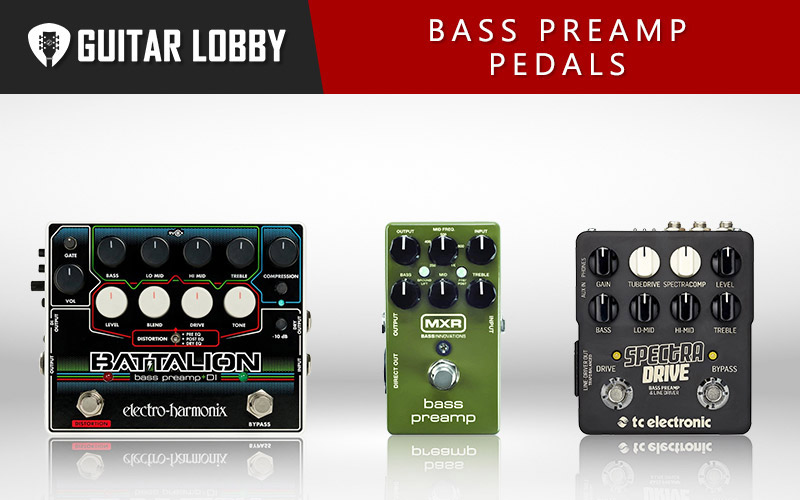
Unfortunately, if you’re a new bass player or if you are not familiar with preamps, it can be hard to find the preamp that’s right for your needs if you don’t know where to start. There are literally hundreds of pedal options on the market at varying price points, but this is where we come in to help find the right pedal for you.
I’ll start this article by reviewing the best bass preamp pedals at different price points, but if you want to know more about them before reading reviews, take a look at the bass preamp buying guide at the bottom of the page here before going through the reviews. We’ll cover what they do, how they work, what are the main features you’ll encounter, and a few tips on how to use them.
| Name of Product | Image of Product | Description | Price Range | Full Review |
|---|---|---|---|---|
| 1. Darkglass Vintage Ultra V2 Bass Preamp (Best Overall) | 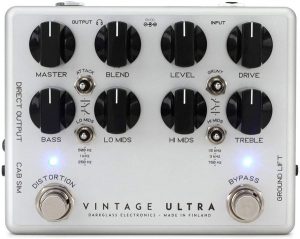 | Type: Analog bass preamp pedal EQ: Shelving 4-band EQ with semi-parametric mids | $360 | Read Full Review Below |
| 2. MXR M81 Bass Preamp (Best Value) | 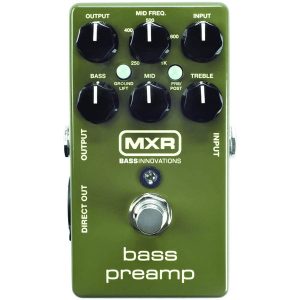 | Type: Analog bass preamp pedal EQ: Shelving 3-band EQ with semi-parametric mids | $170 | Read Full Review Below |
| 3. Behringer V-Tone Bass Driver DI 21 (Best Cheap) | 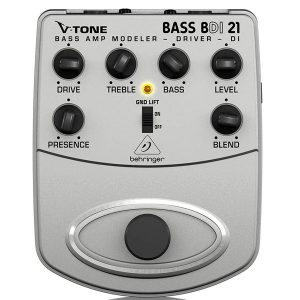 | Type: Analog bass preamp pedal EQ: Shelving active 2-band EQ | $60 | Read Full Review Below |
| 4. EBS MicroBass 3 2-channel Preamp (Editors Choice) | 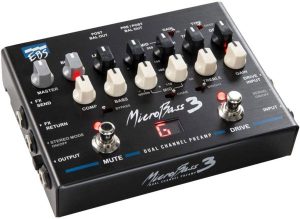 | Type: Analog 2 channel bass preamp pedal EQ: Shelving 3-band EQ with semi-parametric midrange | $400 | Read Full Review Below |
| 5. Aguilar Tone Hammer Preamp/Direct Box | 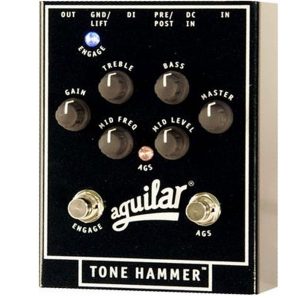 | Type: Analog bass preamp pedal EQ: Shelving 3-band EQ with semi-parametric midrange | $250 | Read Full Review Below |
| 6. Tech 21 SansAmp Bass Driver DI V2 | 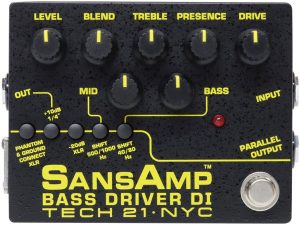 | Type: Analog bass preamp pedal EQ: Shelving 3-band EQ with selectable center frequencies for Bass and Mid | $210 | Read Full Review Below |
| 7. Ampeg SCR-DI – Bass Preamp with Scrambler Overdrive | 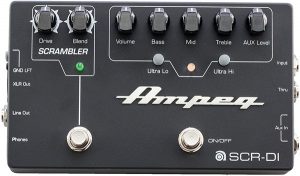 | Type: Analog bass preamp pedal EQ: Shelving 3-band EQ | $250 | Read Full Review Below |
| 8. TC Electronic SpectraDrive Bass Preamp | 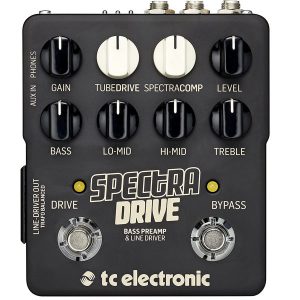 | Type: Digital bass preamp pedal EQ: Shelving 4-band EQ | $200 | Read Full Review Below |
| 9. MXR M80 Bass D.I.+ | 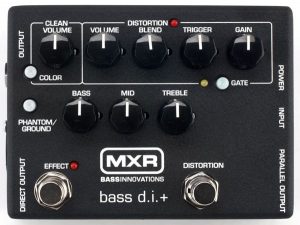 | Type: Analog bass preamp pedal EQ: Shelving 3-band EQ | $140 | Read Full Review Below |
| 10. Electro-Harmonix Battalion Bass Preamp | 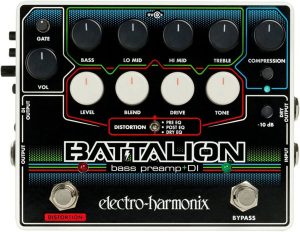 | Type: Analog bass preamp pedal EQ: Shelving 4-band EQ | $230 | Read Full Review Below |
Here Are the Best Bass Preamp Pedals
1. Darkglass Vintage Ultra V2 Bass Preamp (Best Overall)
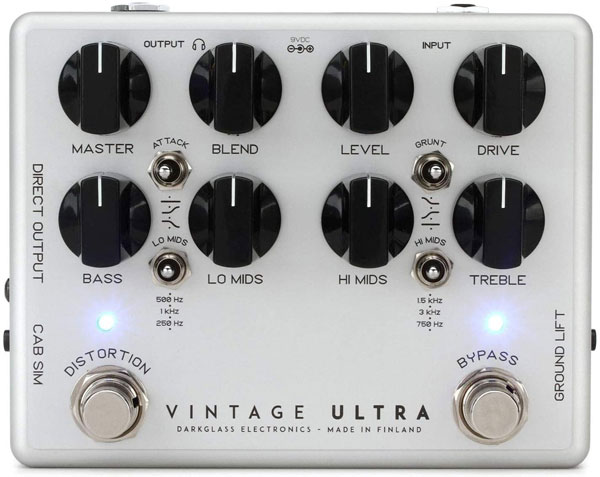
| Estimated Price | $360 |
| Type | Analog bass preamp pedal |
| EQ | Shelving 4-band EQ with semi-parametric mids |
| I/O | 1x¼” input, 1x¼” output, XLR DI out, 3.5mm headphone in, 3.5mm Aux-in |
| Power | 120mA@9V PSU only |
My Review: Darkglass Electronics have taken the bass world by storm in recent years. Their well thought out, high-quality pedals have become some of the top picks among bass players. The Vintage Ultra V2 is truly a gem. In its layout, it is identical to the B7K Ultra, but where the B7K caters to a more aggressive, distortion-heavy side of the crowd, the Vintage brings warm, fat, creamy “vintage” overdrive to the table. It pairs a powerful and versatile preamp and EQ section with a blendable, and separately foot-switchable bass overdrive section. The layout is a little crowded with 8 control knobs, 4 dip switches, and 2 footswitches, but it is fairly intuitive to set up once you spend a few minutes with it. First is the bottom row of control knobs, this is your EQ section. It features Bass, Low Mid, High Mid, and Treble knobs, both the mids having selectable three-way center frequency dip switches.
The dip switches select the center frequencies for the low and high mids. The center frequencies are well-chosen and they make this preamp very versatile. The master volume lets you set the overall output level of the pedal and enables you to dial in unity gain. The distortion footswitch activates the overdrive section on top of the preamp/EQ section, engaging it gets you access to the Drive, Level, and Blend knobs and their 2 dip switches marked Attack and Grunt, that control the way the overdrive reacts to the high and low frequencies respectively (flat, cut or boost). The Vintage Ultra has a very good DI with a digital cabinet simulation (which you can turn off with a switch on the side), making it ideal for an amp-less gig.
You also have a 3.5mm headphone in as well as an aux in, making it possible to practice in silence to your favorite tracks. The Drive knob sets the amount of overdrive while the level sets the volume of the overdriven signal. Blend lets you mix your clean signal with the overdriven one. The Vintage Ultra has a very wide range of sounds on offer, from a clean boost with the overdrive section turned off, to a light, creamy overdrive. With the Drive knob cranked up, you almost get into distortion territory and the noise levels are truly excellent. As a bonus feature, you can load different cabinet simulations from your computer through the free Darkglass Suite software, available for download on the Darkglass website.
Key Specs: The Vintage Ultra V2 is one of the best preamp pedals around, and also one of the most versatile. The active EQ lets you boost or cut Bass, Lo Mids, Hi Mids, and Treble by +/- 12 dB. The switchable center frequencies for Lo Mids(250Hz, 500Hz, and 1kHz) and Hi Mids(750Hz, 1.5KHz, and 3kHz) make this preamp very versatile. You also get a DI with ground lift switch and cab simulation, 3.5mm Headphone in, and 3.5mm aux in. The pedal draws 120mA from a 9V PSU and doesn’t take 9V batteries. The build quality is excellent and the form-factor is pedalboard friendly.
Target Customer: This is a premium pedal for the demanding bass player. The sounds it offers are top-notch and it does everything you could ask from a preamp, except maybe heavy distortion (but that’s what the B7K is for). It’s easy to use and the tonal results are in a class of their own. From vintage to modern sounds, anything goes and it goes very very well.
Bottom Line: The Vintage Ultra is a high-quality pedal with premium build and sounds, it’s not cheap but you get much more than you pay for it. It doesn’t matter if you’re a new player or a seasoned professional, you won’t be disappointed by this one.
2. MXR M81 Bass Preamp (Best Value)
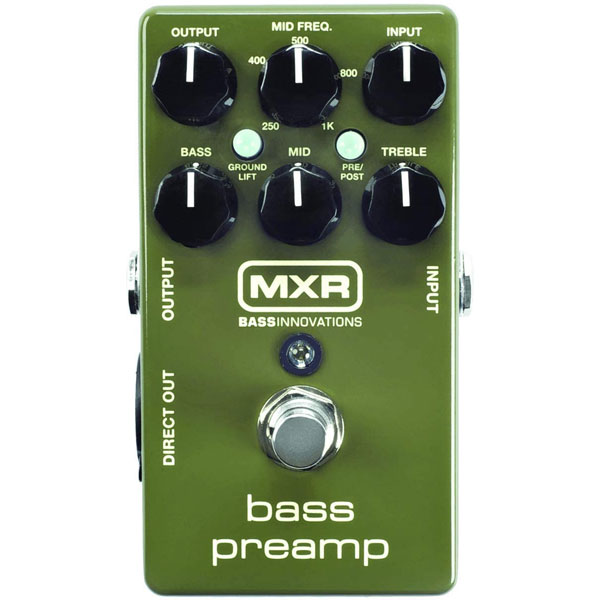
| Estimated Price | $170 |
| Type | Analog bass preamp pedal |
| EQ | Shelving 3-band EQ with semi-parametric mids |
| I/O | 1x¼” input, 1x¼” output, XLR DI out |
| Power | 9V PSU or 9V block battery |
My Review: MXR makes great pedals, this we already know, but the M81 is in a class of its own. It’s the smallest pedal on our list, and it still has all the features you would want from a bass preamp. The M81 is housed in the standard MXR enclosure, and has a 6 knob layout with 2 additional switches – it’s a little crowded on the faceplate but it’s manageable. The heart of the M81 is the 3-band active EQ with a sweepable midrange that lets you boost or cut Bass (+/-16 dB@40Hz ), Mids (+/-17dB @250Hz,400Hz, 500Hz, 800Hz, or 1kHz), and Treble (+/-18dB@4kHz). The Input controls your pre-EQ gain, Output lets you set the overall output volume, and the Mid Frequency knob lets you select the mid-frequency.
The 2 switches are ground lift (to eliminate feedback loops), and a pre-post switch that determines whether the Direct Out signal on the DI is affected by the EQ settings or if it outputs a completely dry signal to the XLR. When you first plug it in you realize that this is a very clean preamp, it doesn’t really do overdrive or crunch, but what you get is an almost surgical tool to shape your clean tone with a very low noise floor. The midrange sweep lets you exquisitely shape the part of the frequency spectrum that is most important to us bass players with very good results. You can also choose to disable the DI out or choose between buffered bypass and true bypass via internal dip switches.
Key Specs: The M81 is a high-quality clean bass preamp, with a 3-band active EQ that has a selectable midrange. It has separate Input and Output level controls letting you easily set unity gain. The EQ features a cut or boost function for Bass (+/-16 dB@40Hz ), Mids (+/-17dB @250Hz,400Hz, 500Hz, 800Hz, or 1kHz) and Treble (+/-18dB@4kHz). It has a studio-quality balanced XLR DI out with a ground lift switch and a pre/post EQ switch giving you the option to select if your DI signal to the console or PA is affected by the EQ settings or not. It can run on a 9V block battery as well as a 9V standard PSU.
Target Customer: The MXR M81 caters to the straight forward, no-frills bass player, no overdrive, just a clean, boosted signal, and pure bass tone shaping. It’s very easy to set up making it ideal for new players and pros alike. It’s just a great pedal with good build quality at a very good price.
Bottom Line: If you are somewhat on a budget and looking for a high-quality, small form-factor, clean preamp to fit on your pedalboard, then this is the pedal you want to take a closer look at. Overall, I would say that this is the best bass preamp pedal for the money.
3. Behringer V-Tone Bass Driver DI 21 (Budget Pick)
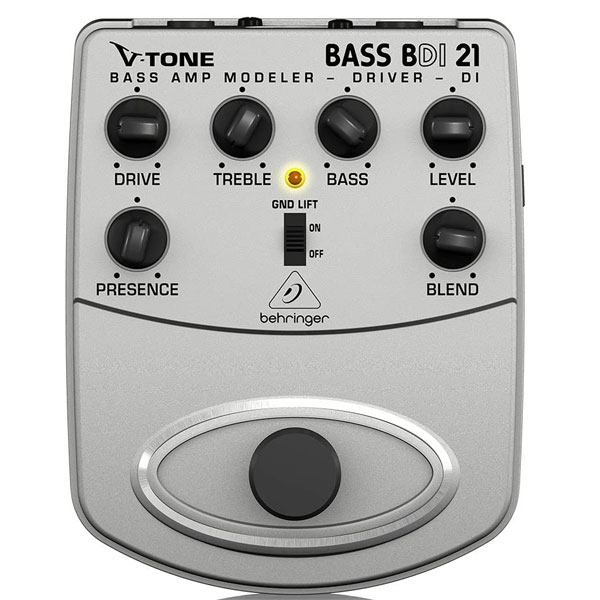
| Estimated Price | $60 |
| Type | Analog bass preamp pedal |
| EQ | Shelving active 2-band EQ |
| I/O | 1x¼” input, 1x¼” output, XLR DI out |
| Power | 9V PSU or 9V block battery |
My Review: Behringer has been around forever, offering very cheap and usually very good copies of legendary effects pedals, and the V-tone Bass Driver DI fits right into the mold. As the name suggests and as far as I can tell, it’s a clone of the version 1 SansAmp Bass Driver DI. It is housed in a sturdy and compact plastic enclosure with a 6 control knob layout. The V-Tone BDI features a 2-band active EQ with Bass and Treble that can be cut or boosted by +/-12dB. The Presence control lets you boost the harmonic content of the high-end for greater attack. The Drive control knob sets the amount of gain and overdrive similar in tone to pushing the output stage of a tube amp.
The Level control determines the overall output volume, while Blend adjusts the amount of tube emulation mixed in with your EQed tone. There’s a balanced XLR DI out that lets you plug in directly into a console or PA and it also has a ground lift switch on the faceplate to eliminate ground loops. The BDI 21 has a surprisingly wide range of usable sounds in the low to mid-gain spectrum, with warm, crunchy tube-like tones. High gain sounds tend to sound a little fluttery but still decent. The noise levels are acceptable except with the Level cranked all the way up. It sounds best when used as a clean boost with just a little bit of added grit, very similar to the Bass Driver it is based on. A disadvantage to the BBDI 21 is the lack of mid-range control, but even without it, it’s versatile enough and offers vintage tones as well as more modern sounds with a warm, tube-like emulation.
Key Specs: The BDI 21 is a clone of the original SansAmp Bass Driver housed in a smaller plastic enclosure and sports an active 2-band EQ with Bass and Treble that can be boosted or cut by 12dB. Drive adjusts the amount of overdrive and the Level control lets you dial in unity gain. The DI has a balanced XLR out with a ground lift switch to avoid grounding issues. It is a buffered bypass pedal, same as the original, and can be powered either by a standard 9V PSU or 9V block battery.
Target Customer: If you are new to bass preamps and are on a budget, this is the ideal pedal to start with. It has a good range of vintage and modern sounds on offer and at its price point, it’s a steal. It can sometimes be a little tricky to get its tone right, but it’s the same as the original SansAmp in this respect.
Bottom Line: With the V-tone BBDI 21 you get a bass preamp, based on a legendary pedal at the price of a good set of bass strings. In the bang-for-buck category, it’s unbeatable.
4. EBS MicroBass 3 2-channel Preamp (Editor’s Choice)
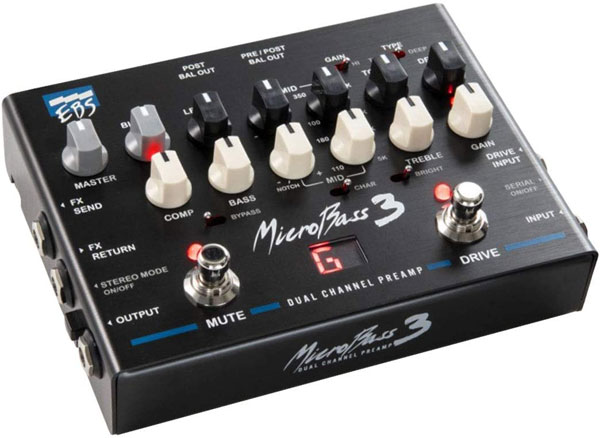
| Estimated Price | $400 |
| Type | Analog 2 channel bass preamp pedal |
| EQ | Shelving 3-band EQ with semi-parametric midrange |
| I/O | ¼” instrument in, ¼” drive input, 3.5mm aux in, ¼” return; ¼” instrument out, balanced XLR post-EQ, Balanced XLR pre/post EQ, ¼” send, 3.5mm headphone out |
| Power | 400mA@9V PSU |
My Review: If there ever was a swiss army knife of bass preamps, then the Swedish manufacturer EBS has built it with the MicroBass 3. It is a high-quality bass preamp that features two individual channels for clean and distorted sounds. Each channel has its own EQ section and a plethora of tone-shaping microswitches to determine the voicing and response of the preamp. It features extensive and flexible routing options making it ideal for professional use, whether live or in the studio. The build quality is excellent and the control knobs and switches have a pleasing resistance to them. At first glance, the control layout may seem overwhelming, but it is quite easy to use and set up once you’re familiar with it. The control knobs are color-coded for each channel: the clean channel controls are white, the overdrive channel controls are black, and the controls that are common to both channels are gray.
The clean channel features an input gain control, a 3-band EQ with semi-parametric mids, a one-knob compressor, the Character switch creates a mid-scooped sound, and the Bright switch boosts treble by 10dB@10kHz. The drive channel retains the semi-parametric midrange controls but replaces the Bass and Treble controls with a Tone knob, Drive determines the amount of overdrive while Level sets the volume of the drive channel. The switches for the drive channel let you select high- or low gain mode, while Type toggles between a thin or deep distortion sound. The Blend control knob lets you mix the clean and drive channels to your liking and the Master control adjusts the overall output volume. You can choose to cascade the clean channel into the drive channel for clean/drive channel stacks. The MicroBass 3 features a stereo effects loop with a stereo return, which you can toggle with a switch on the side. The dedicated Mute footswitch activates the built-in tuner when pressed. The clean channel is transparent and doesn’t add any coloration to your fundamental tone, aside from the EQ settings, while the drive channel lets you dial in anything from a warm, vintage tube-like crunch to heavy modern metal distortion.
Key Specs: The MicroBass 3 is a bass preamp with 2 independent channels for clean and drive. The clean channel features a 3-band EQ with semi-parametric mids. It has a built-in one-knob compressor with a 3:1 maximum ratio, and a tuner. It has 4 inputs: ¼” instrument in, ¼” drive input, 3.5mm aux in, ¼” return, and 5 outputs: ¼” out, balanced XLR post-EQ, Balanced XLR pre/post EQ, ¼” send, 3.5mm headphone output. It runs on a 9V PSU only drawing 400mA for high headroom and low noise. Lastly, it has a true bypass switch.
Target Customer: The 2 channel design and extensive routing options make the MicroBass 3 ideal for any player with complex or versatile requirements. The sound and build quality are extremely high and the price reflects this fact. If you like to be in total control of your preamp and price is not a factor, take a look at the MicroBass 3 from EBS.
Bottom Line: The versatility of this pedal is second to none, its premium sounds, extensive routing capabilities, high headroom, and extremely low noise-floor make the MicroBass 3 one of the best bass preamps on the market, period.
5. Aguilar Tone Hammer Preamp/Direct Box
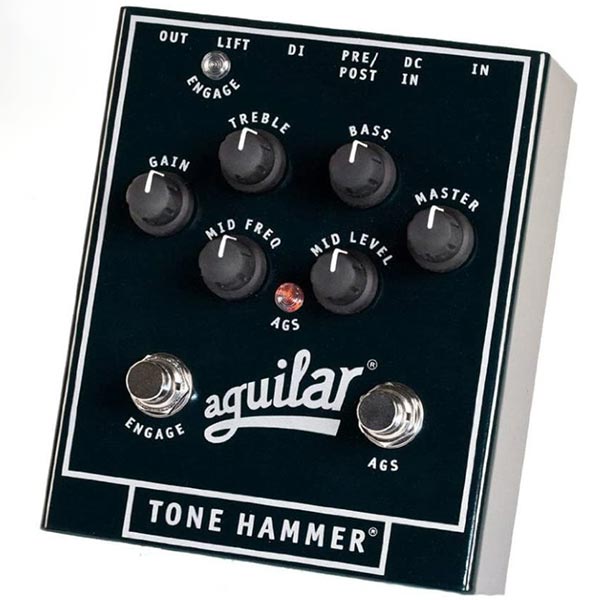
| Estimated Price | $250 |
| Type | Analog bass preamp pedal |
| EQ | Shelving 3-band EQ with semi-parametric midrange |
| I/O | 1x¼” input, 1x¼” output, XLR DI out |
| Power | 7mA@9V PSU, Phantom Power, or 2x 9V block batteries |
My Review: Aguilar is one of the greats in the bass world offering pickups, preamps, amps, cabinets, and effects to bass pros all over. But the Tonehammer preamp is special, so special in fact that it sparked their very successful Tonehammer Amp lineup. It is built like a tank and has a hefty feel to it. The preamp features a powerful active 3-band EQ with a fully sweepable midrange and an added overdrive section which they call AGS (Adaptive Gain Shaping). Both the preamp and AGS have their own footswitches but the preamp needs to be engaged for the AGS to work.
The pedal has a 6- knob layout with Bass, Treble, Mid-frequency, Mid Level, Master, and Gain. The Master control sets the output volume for the pedal, while Gain determines the amount of overdrive and is added to the EQ by toggling the AGS switch. This lets you have 2 distinct sounds at the push of the AGS footswitch. The Tonehammer is very easy to use and set up, mainly because you can’t make it sound bad whatever settings you choose. It is a very quiet pedal with a low noise floor, even with the gain turned up. This is a quite versatile pedal with a wide range of excellent sounds, from a subtle clean boost to almost fuzz-like overdrive, it does it all.
Key Specs: The Tonehammer is a dedicated bass preamp housed in a heavy-duty steel enclosure. It features a 3-band EQ with a fully sweepable midrange (Bass +/- 18dB @ 40Hz, MId +/-17dB @ 180Hz-1kHz, Treble +/-18dB@ 4kHz). The AGS footswitch engages the Overdrive section of the pedal on top of the EQ. A bonus is the internal 18V operation which gives you headroom to spare. It sports a balanced XLR DI out with pre/post EQ and ground lift switches in addition to the standard ¼” jack input and output. You have three options to power it: with two 9V block batteries, a PSU, or by Phantom power which is really nice
Target Customer: The Tonehammer is a premium bass preamp from a reputed manufacturer, its simplicity of use and wide range of tonal options make it ideal for any level of bass player in any style of music, but it truly shines with clean and low to medium-gain settings, offering transparent tone-shaping and warm tube-like overdrive in a tank-like enclosure.
Bottom Line: From great vintage sounds to modern, heavily overdriven basslines, the Aguilar Tonehammer really is what its name suggests: a tool to hammer your tone into the shape you desire.
6. Tech 21 SansAmp Bass Driver DI V2
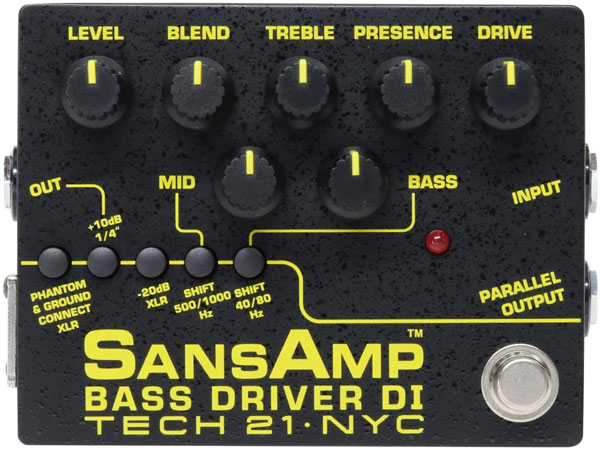
| Estimated Price | $210 |
| Type | Analog bass preamp pedal |
| EQ | Shelving 3-band EQ with selectable center frequencies for Bass and Mid |
| I/O | 1x¼” input, 1x¼” output, 1x¼” parallel output, XLR DI out |
| Power | 9V PSU, 9V block battery or Phantom Power |
My Review: The SansAmp Bass Driver DI is a classic that has been in production for ages, and with good reason – it is a reference pedal among bass preamps. It probably is the best selling preamp/DI for the bass guitar. And the V2 is even better than the original. One of the drawbacks of the original was a lack of mid control which Tech 21 has corrected by making it an active 3-band EQ with +/-12 dB cut/boost instead of the old 2-band EQ with only bass and treble controls. They also added selectable center frequencies for the mids (500Hz or 1000Hz) and bass (40Hz or 80Hz) making this preamp better suited for extended range basses.
The footswitch will only activate the SansAmp Tube Amplifier Emulation circuitry, it is not a bypass for the pedal. Besides the EQ, on the faceplate you will find the control knobs for Drive – adjusting the overall gain structure, Presence – controlling the amount of upper harmonic content, Level – sets the levels for standard ¼” and XLR out and Blend – mixes your EQed dry signal with the Tube Emulation circuitry. Balancing levels on the BDDI can sometimes feel a little cumbersome as the Drive, Blend, and Level knobs all influence each other, but it’s nothing you can’t get used to after playing with it for a few minutes. The sonic range you can expect from this pedal is all centered around tube-like warmth and harmonically rich, overdriven sounds. The cleanest sounds it offers will still have an overdriven tube-quality to them, which is not a bad thing if that is what you are looking for.
Key Specs: The BBDI is an always-on bass preamp that’s built like a tank. It features a 3-band active EQ with boost or cut function (Bass, Mid, Treble +/-12dB) and 2 selectable frequencies for Mid (500Hz or 1000Hz) and Bass (40Hz or 80Hz). It offers 3 output solutions: a ¼” out with +10dB selectable through a switch, a ¼” parallel out from which you’ll get a completely dry signal, and the balanced XLR out with selectable -20dB also through the use of a switch on the faceplate. It can be powered either with a 9V PSU, 9V block battery, or by Phantom Power.
Target Customer: If you want a preamp that preserves the natural character of your bass, this is not the one. But if you like vintage tube amps or play a heavier style of music, you’ll love the SansAmp BBDI. It’s not the easiest to set up right, but it’s nothing that spending a few minutes with it won’t solve.
Bottom Line: The Bass Driver DI is a workhorse for the bass player masses, you’ll get classic tube sounds, a great DI, and it won’t break the bank.
7. Ampeg SCR-DI – Bass Preamp with Scrambler Overdrive
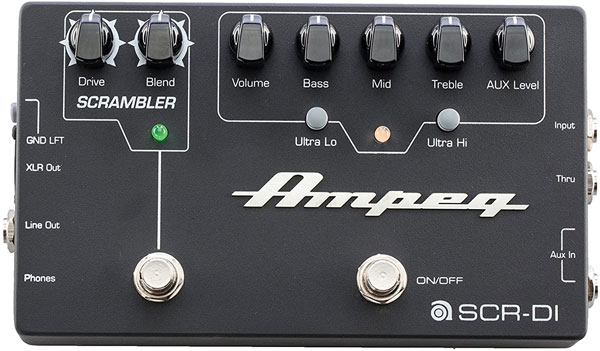
| Estimated Price | $250 |
| Type | Analog bass preamp pedal |
| EQ | Shelving 3-band EQ |
| I/O | 1x¼” instrument input, 1x¼” aux in, 1×3.5mm aux in, 1x¼” instrument output, 1x¼” thru out, 1×3.5mm headphone out, XLR DI out |
| Power | 100mA@9V PSU or 9V block battery |
My Review: If you’ve ever dreamed of having an Ampeg full stack in your gigbag, then maybe the Ampeg SCR-DI is the bass preamp for you. The pedal is divided into 2 sections, the preamp section and the overdrive/distortion section also called the Scrambler. The preamp section is minimalistic in its layout with a Volume knob that sets the overall output volume, 3-band active EQ, and Aux Level – setting the volume for the two auxiliary inputs and 2 switches for the UltraHI and UltraLo circuits.
The UltraLo switch gives you a mid-scooped sound, while UltraHi boosts your high-end content. The scrambler has 2 control knobs: Drive which controls the amount of overdrive and Blend which blends the former with the signal coming from the preamp section. It has an on/off footswitch for the preamp and an on/off footswitch for the scrambler. But in classic Ampeg fashion, from such minimalism comes true greatness. The preamp offers a good range of clean sounds and in combination with the overdrive section, you get access to anything from a creamy, smooth, lightly overdriven tone up to heavy distortion sounds. Besides being an Ampeg full-stack simulator with a great DI and great sounds, you can use it as a standalone practice amp, thanks to the aux inputs and headphone output.
Key Specs: The SCR-DI is a bass preamp and DI housed in a solid metal enclosure with a 3-band EQ: Bass (+/-14dB@40Hz), Mid (+5dB/-11dB@500Hz), Treble (+16dB/-15dB@4kHz), the UltraLo switch provides a mid-scooped tone with +1dB@40Hz and -10dB@500Hz, while UltraHI boosts the treble content by +5dB@8kHz.
There are 3 inputs: the standard ¼” instrument in and two Aux inputs, one in 3.5mm, the other in ¼” and there are 4 outputs: a dry ¼” out, a ¼” effected out, a balanced XLR DI out plus a 3.5mm Headphone out. The DI is clean and transparent and features a ground lift switch to eliminate grounding issues. The SCR-DI draws 100mA from a 9V PSU or a 9V block battery.
Target Customer: This is a good quality bass preamp pedal with great connectivity features and a good selection of usable sounds. It’s very easy to set up and the simple layout won’t turn away inexperienced bass players. The fact that it can be used as a standalone practice tool makes the SCR-DI a much more versatile pedal than many others out there.
Bottom Line: The SCR-DI offers a lot of features, very good overdrive and distortion sounds, with good build quality at a fair price. It’s a great choice for any bass player be it a pro or newcomer.
8. TC Electronic SpectraDrive Bass Preamp
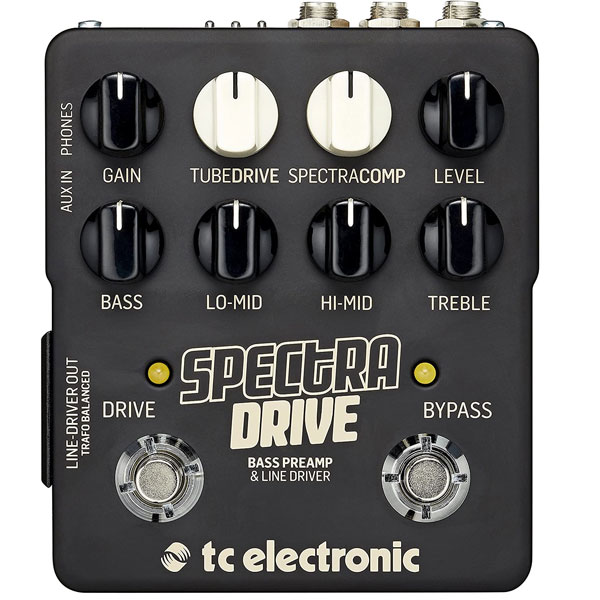
| Estimated Price | $200 |
| Type | Digital bass preamp pedal |
| EQ | Shelving 4-band EQ |
| I/O | 1x¼” input, 1×3.5mm aux in, 1x¼” output, 1x¼” thru out, 1×3.5mm headphone out, XLR DI out |
| Power | 250mA@9V PSU only |
My Review: By now we know that TC Electronic like to make versatile pedals, but the SpectraDrive might be the most versatile they’ve created so far. The SpectraDrive is housed in TC’s standard double footswitch enclosure and feels rugged and sturdy. Its preamp section features a 4-band active EQ with Bass, Lo-Mid, Hi-Mid, and Treble controls as well as a Gain control for the amount of overdrive and a Level control that sets the overall output volume. You also get a one-knob compressor controlled by the SpectraComp knob and the TubeDrive Knob that adjusts the level of the Tube Drive circuit together with the Gain knob. The distinguishing feature of the SpectraDrive is its TonePrint capability.
This means that you effectively have a SpectraComp compressor with dozens of TonePrint profiles on offer and the TubeDrive circuit which also has its dozens of TonePrint presets, paired with a preamp that brings it all together. To say that this is a sonically versatile pedal is a gross understatement. The 4-band EQ’s range varies along with the loaded TonePrint. The Bypass footswitch engages the preamp section and the SpectraComp compressor, while the Drive footswitch turns on the TubeDrive circuit. In operation, the SpectraDrive is near noiseless and the DI is transparent and crystal clear. It can be also used as a standalone practice amp due to its aux in and headphone out.
Key Specs: The SpectraDrive is essentially a TonePrint-enabled bass multi-effects unit with its focus on overdrive and distortion. The 4-band EQ features variable ranges according to the selected TonePrint: Bass (has a max cut of -24dB@50Hz and a max boost of +24dB@80Hz), Lo-Mid (+/-12dB@160-200Hz), Hi-Mid (+/-18dB@630-800Hz), and Treble (+/-24dB@1800-2800Hz). The SpectraDrive has 2 inputs: ¼” instrument in, 3.5mm aux in, and 4 outputs: ¼” instrument out, ¼” thru out, 3.5mm headphone out, and the DI XLR balanced out with its 3 switches(ground lift, pre-post switch, and instrument level/line level output switch). Connecting the pedal to a PC or Mac through the Micro USB port, lets you load your desired TonePrints and it has a buffered bypass that maintains your signal’s integrity through long cables or a convoluted pedalboard setup.
Target Customer: The SpectraDrive is a tweaker’s delight. It offers unparalleled tonal flexibility with its TonePrint functions, giving you access to dozens of preamp/overdrive combinations as well as the built-in SpectraComp compressor. It takes a more experienced bass player to get everything out of it and to set it up quickly, but as experimentation is key, bass players of all levels can easily reap its rewards.
Bottom Line: The SpectraDrive is a great pedal with great build quality almost endless tonal versatility. You get virtually dozens of preamps in one pedal and it is very competitively priced for all that it brings to the table.
9. MXR M80 Bass D.I.+
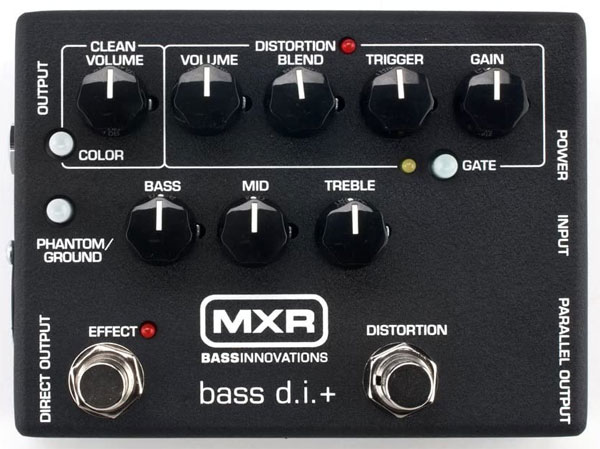
| Estimated Price | $140 |
| Type | Analog bass preamp pedal |
| EQ | Shelving 3-band EQ |
| I/O | 1x¼” input, 1x¼” output, 1x¼” parallel output, XLR DI out |
| Power | 9mA@9V PSU or 9V block battery |
My Review: The MXR M80 is a high-quality bass preamp and D.I. box with two separate channels for clean and distortion sounds. The clean preamp section features an active 3-band EQ with Bass, Mid and Treble controls as well as a Clean Volume knob (active only when the clean section is engaged using the Effect footswitch) and the Color switch that gives you a midrange boost when pressed. The distortion section of the M80 is engaged by pressing the Distortion footswitch, at this point the Clean Volume becomes inactive and you get access to the Gain (sets the amount of distortion), Volume (determines the overall output volume of the pedal), and Blend (mixes your dry and distorted signals) control knobs.
The pedal has a handy noise gate that keeps noise levels manageable, it is activated by pressing the Gate switch, and its sensitivity is dialed in with the Trigger control knob. The clean channel lets you subtly shape the bass tone to your liking, while the distortion channel gets you a wide range of overdrive and distortion sounds, with an emphasis on the distortion side of things. You get some nice overdriven sounds but they are not as warm and smooth as with other preamps. But where the M80 lacks in its overdrive capability, it makes up for in its distortion circuit. It offers harmonically rich, dynamic, and punchy distortion sounds perfect for any modern metal or punk gig.
Key Specs: The M80 is a well-built, good quality bass preamp with individually switchable clean and distortion sections. The clean section features a 3-band active EQ with Bass (+/-18dB@60Hz), Mid (+/-10dB@850Hz), and Treble (+/-12dB@4kHz) controls. The Clean volume is active only while the Effect footswitch is engaged (with the distortion off). The distortion section of the pedal is activated by pressing the Distortion footswitch, at this point the Gain, Blend, and distortion Volume controls become active as well as the built-in noise gate (toggled on/off by the gate switch, the sensitivity is set with the Trigger knob). The M80 has a ¼” instrument input, a ¼” output, a ¼“ parallel output, and the balanced XLR D.I. output. The M80 can be powered by a 9V PSU, 9V battery, or by Phantom power.
Target Customer: The M80 is aimed at the modern rock and metal bass player who demands simplicity and versatility from his or her preamp pedal. The setup is straight-forward without the need to browse through the manual, making it ideal for all players wanting to just plug it in and rock.
Bottom Line: The M80 Bass D.I.+ offers a good mix of clean and distortion sounds at a very reasonable price. And the fact that it’s a high gain amp-in-a-box, makes it all the more appealing.
10. Electro-Harmonix Battalion Bass Preamp
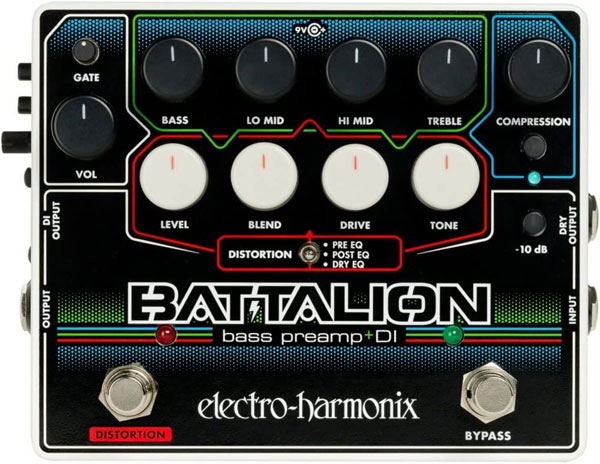
| Estimated Price | $230 |
| Type | Analog bass preamp pedal |
| EQ | Shelving 4-band EQ |
| I/O | 1x¼” input, 1x¼” output, 1x¼” dry output, XLR DI out |
| Power | 100mA@9V PSU only |
My Review: The EHX Battalion Bass Preamp was designed as a full bass rig in a box. It’s a preamp and a DI, it has a distortion circuit, a one-knob compressor, and a built-in noise gate. The preamp features a 4-band active EQ that boosts/cuts Bass, Lo Mid, Hi Mid, and Treble frequencies. The EQ section is activated by pressing the bypass footswitch. The distortion section features a 4-knob layout, Drive setting the amount of distortion, Level sets the output level of the distortion section, Blend controls the mix between the dry and distorted signals, and Tone cuts Treble from the distorted signal. The distortion section is engaged with the press of the Distortion footswitch.
The distortion 3-way dip switch lets you select where the distortion effect comes into the signal path: pre EQ, post EQ, or dry EQ. The compressor is activated with a toggle switch and its ratio is set with the compression knob. The Volume knob controls the overall output volume of the pedal. The Gate knob sets the threshold for the noise gate. The ¼” output doubles as a headphone out, making the Battalion perfect for quiet practicing. This preamp does it all: a powerful EQ section, a fully blendable distortion section with a wide range of sounds, but fairing better on the high-gain end of the distortion spectrum. The compressor is a welcome addition and the various routing options make the Battalion a versatile tone shaping tool in a relatively compact form-factor.
Key Specs: The Battalion is an all-analog, feature-packed bass preamp pedal with a compressor, a 4-band EQ, a distortion circuit, a noise gate, and a good DI. The Bass knob boosts/cuts frequencies below 200Hz, the Lo Mid knob boosts/cuts frequencies @280Hz, the Hi Mid knob boosts/cuts frequencies @750Hz, Treble boosts/cuts frequencies above 2 kHz. The DI has its own volume control on the side of the pedal as well as a ground lift switch to avoid grounding issues. The Battalion draws 100mA@9V from a PSU only.
Target Customer: If you are sick of lugging around your amp and your basic pedalboard, then the EHX Battalion could be your go-to pedal. It is packed full of useful features and has extensive routing options making it the perfect preamp for any situation whether live-gigging or in the studio. It’s straightforward to set up and use regardless of your level of experience, and it does very well in any style of music, but with an emphasis on the high-gain end of the distortion spectrum.
Bottom Line: The Battalion is a great all-round bass preamp with good build quality, great tonal versatility, and a price-tag that makes it hard to pass up.
Choosing the Right Bass Preamp Pedal (Buying Guide)
In a general sense, a preamplifier or “preamp” is a piece of electronic equipment used to increase the volume of your signal ( measured in Decibel or dB ) until it reaches the standard dB which all studio and live equipment work with, known as “line-level”. The signal from a microphone or instrument is generally weak and prone to generate high noise levels, so a preamp converts your weak signal to a higher voltage with a higher noise tolerance before sending it to a power amplifier and speaker. Simply put it makes your signal louder, preparing it for amplification or further processing by other effects in your signal chain, without this your signal would be noisy or distorted. If you are using an amp or combo with your bass, you’re already using a preamp, as the EQ section is part of the preamp. Besides boosting your signal to prepare it for amplification, it also lets you shape the bass tone to a certain extent.
Types of Bass Preamps
Tube preamplifiers: As the name suggests, they use vacuum tubes to amplify your signal, and are the oldest tech used in amplification. They are not transparent as they add a lot of harmonic distortion and color your sound. The sound they impart is warm and fat and are sometimes used in more high-end pedals to add a vintage tone to your signal.
Transistors are the main tech employed in most preamp pedals. They have a transparent sound with little inherent tone coloring and are relatively inexpensive to produce.
Equalization
You have probably used EQs many times but there are a lot of misunderstood things about how they work, and how their controls affect your sound.
The EQ section of a preamp pedal will be the main tone-shaping tool at your disposal. EQs come in 4 varieties: Shelving, Graphic, Parametric, and Semi-parametric.
Shelving EQ
This is the most basic and inexpensive type of EQ, it can be found on most basic audio equipment. It usually lets you control the Bass, Mid, and Treble. Their central frequencies and bandwidth are fixed. This type of EQ is a simple and straightforward way to control the basic equalization parameters. Because of the shelving EQ’s simplicity, you’ll find it less often on professional audio equipment, but most basic preamp pedals will make use of it.
Graphic EQ
The graphic EQ is probably the most used in professional audio equipment. It features a bank of slider controls to cut or boost fixed frequency bands. Most graphic equalizers divide the sound between 6 and 31 bands of frequency, with the sliders controlling the volume of individual bands. Each band is marked in Hz with the frequency it controls. Graphic EQs are very easy to use as the shape of the slider curve usually adheres to the shape of the audio curve of the signal – if you want a “mid-scooped” bass sound, you’ll dial in a roughly U shaped curve on the EQ’s sliders, hence the “graphic” in its name. This type of EQ is less common in a pedal format, but there certainly are a number of them that feature it.
Parametric EQ
The parametric EQ is the most versatile and precise type of equalizer available, letting you control all of the parameters of your equalizer. While parametric EQs usually feature fewer frequency bands than a graphic EQ, the former offers a lot more control. It usually allows you to set the center frequency, as well as gain, and bandwidth or Q. The center frequency is the frequency you choose to alter, the gain is the amount of boost or cut to be applied to the frequency, the bandwidth is the range of the frequency band that gets affected (the center frequency being right in the middle), Q is the slope of the EQ (a narrower bandwidth has a higher Q factor with a steeper slope and more aggressive EQ). The downside of the parametric EQ is that you need to spend more time with it to understand what everything does and to dial in the sound you want, but it is the most versatile of all the EQ types. It is often found on studio equipment, and more rarely on a pedal where you want quick and easy ways to shape your tone.
Semi-parametric EQ
The semi-parametric EQ is very similar to a parametric EQ, but with one or more features missing. Typically, it allows you to set the frequency you want to equalize and the gain (the amount of cut or boost you want to apply to that frequency). Bandwidth or Q controls are fixed in a semi-parametric EQ. This type of EQ is a good tradeoff between versatility and ease of use.
What Features to Look for in a Bass Preamp?
Most bass players choose to add a bass preamp to their rig because they want to have more control over their bass tone. This is generally achieved in two ways: the gain stage and the EQ.
A preamp will boost your signal and increase your gain, but how much boost you need or want is a good thing to consider when looking for a preamp. There are preamps out there that only offer a clean boosted signal in the gain stage regardless of how much you crank up the gain knob. If you are looking for something to add warmth or grit to your tone, a clean boost will probably not satisfy you. On the other hand, some preamps offer overdrive or even distortion levels of boost.
The second way in which preamps let you alter your tone is the EQ section. As stated above, there are 4 types of EQ and there are pedals out there featuring all of them. If you like to be in full control and tweak your sound, then maybe a simple shelving EQ will not do the trick for you. If you just want to have an extra bass sound at the tip of your toes that’s quick to set up without having to tweak the EQ on your amp, a pedal with a parametric EQ might be overkill.
As with any increase in gain, noise can be a nasty byproduct, so a good preamp should add little to no unwanted hum or noise to your sound. But a low noise ratio usually means higher-priced components and build quality, this in turn will drive up the price of the preamp.
Unity gain – If you are using your preamp as an always-on pedal, you can use the amp to adjust the differences in volume as the boost or drive is applied. But if you want to engage your pedal only for certain passages, a “master volume” is a great feature, letting you balance the volume for when the pedal is on or off.
Buffered bypass vs. True bypass True-bypass means that when you switch off your pedal or if it loses power for some reason, your signal will pass through the pedal as if it weren’t there. Some signal degradation does occur but it is less noticeable the fewer pedals you have in your signal chain.
Buffered bypass pedals are useful when you have a long signal chain with a lot of pedals. Each pedal in the chain will leave your signal slightly weaker and degraded. Buffered bypass boosts your signal strength slightly to make up for the natural degradation of the signal. With large pedalboards, it is preferred for the first and last pedals in the chain to be buffered bypass pedals, the first one pushing your signal through the pedalboard chain while the last one pushes the signal through the last cable to the amp. Some pedals let you switch between true bypass and buffered bypass modes.
D.I. or Direct Injection, it is a feature often found on some of the pricier pedals on the market. It takes an unbalanced, high impedance signal like from your instrument and turns it into a balanced, low impedance signal. This means that you can send the signal directly to the console or into the P.A. and it prevents degradation when running the signal through long cables. It just gives you a lot more options when playing live or when recording in the studio.
Tips:
Typically you place a bass preamp at the beginning of your signal chain so that you shape and boost your bass tone before the signal goes through the rest of your pedals.
If you are playing a smaller gig, you can easily pass on carrying around your amp. The DI found in most preamps will let you plug directly into the console or the PA system on location. Showing up with just your gig bag and a preamp will leave your guitar player bewildered, but your tone will still be excellent – it’s just a great option for a working and gigging bass player.
Wrap Up:
Choosing the best of anything is almost impossible especially in a crowded niche such as preamps, so look at the pedals on this list as they are all well made by reputable brands. Remember, knowing what you want from a preamp will set you on the right course and prevent you from spending your hard-earned cash on our top pick that could be ultimately the wrong pedal for your personal vision, style, or tone. We hope this page helped you out, and let us know what preamp you’ll be going with below in the comments. As always, feel free to leave any questions or comments as well.

My name is Chris and I’ve had a passion for music and guitars for as long as I can remember. I started this website with some of my friends who are musicians, music teachers, gear heads, and music enthusiasts so we could provide high-quality guitar and music-related content.
I’ve been playing guitar since I was 13 years old and am an avid collector. Amps, pedals, guitars, bass, drums, microphones, studio, and recording gear, I love it all.
I was born and raised in Western Pennsylvania. My background is in Electrical Engineering, earning a Bachelor’s degree from Youngstown State University. With my engineering experience, I’ve developed as a designer of guitar amplifiers and effects. A true passion of mine, I’ve designed, built, and repaired a wide range of guitar amps and electronics. Here at the Guitar Lobby, our aim is to share our passion for Music and gear with the rest of the music community.

Seems like the SpectraDrive is no longer available. I would have liked to try one. I get tired of bass preamps that spend too much energy on distortion variations and not enough on a clean, flexible and uber quiet main channel with DI.